Motion Sickness in Other People’s Cars – What’s Going On?
Ever hop into a friend's car and suddenly feel like the world is spinning? You’re not alone. A lot of us get queasy in rides that aren’t our own, and the culprit is usually a mix of motion, smells, and how our brain processes balance.
First off, motion sickness happens when the inner ear, eyes, and brain send mixed signals about movement. Your ear says you’re moving, your eyes might see a still interior, and your brain gets confused. That mismatch fires off nausea, sweating, and that dreaded urge to step out.
What Triggers the Nausea?
Here are the top triggers that make other people’s cars feel worse than your own:
- Irregular driving patterns. Drivers who brake hard, accelerate quickly, or take sharp turns create sudden shifts that your body can’t predict.
- Unfamiliar scents. Air fresheners, cleaning sprays, or even the perfume your friend is wearing can irritate your nose and stomach.
- Seat position. Sitting in the back, especially without a window view, removes visual cues that help your brain gauge motion.
- Reading or screen time. Staring at a phone or book while the car bounces tricks the brain even more.
- Dehydration or an empty stomach. Low blood sugar or not drinking enough water makes you more sensitive to motion.
All these factors pile up, and before you know it, you’re reaching for the nearest stop.
Practical Ways to Stay Comfortable
Good news: you can beat car nausea with a few simple habits.
1. Choose the right seat. Sit in the front passenger spot or the middle seat if you’re in a larger vehicle. You’ll have a clearer view of the road and fewer sudden turns.
2. Focus on the horizon. Keep your eyes on a steady point outside the car. It helps sync the visual input with what your ears feel.
3. Keep the air fresh. Open a window a crack or use the car’s vent to circulate air. If a particular scent bothers you, ask the driver to skip the air freshener.
4. Stay hydrated. Sip water before you hop in and bring a bottle along. Avoid caffeine and alcohol, which can worsen dehydration.
5. Light snacks work wonders. A few crackers, a banana, or a small piece of cheese keeps blood sugar steady and settles the stomach.
6. Use ginger. Chewing on ginger candy or sipping ginger tea can calm nausea for many people.
7. Take breaks. On long trips, stop every hour or two. Walk around, stretch, and let your body reset.
8. Try over‑the‑counter remedies. If you know you’re prone to motion sickness, an antihistamine like dimenhydrinate taken 30 minutes before traveling can help.
It’s also worth chatting with the driver. Let them know you get motion sick and ask for a smoother ride if possible. Most people appreciate the heads‑up and will try to brake gently.
Another trick is to control what you focus on inside the car. If you must use a phone, switch to audio books or podcasts. Listening keeps your mind occupied without overloading your eyes.
Finally, practice deep breathing. Inhale through your nose for four counts, hold for two, then exhale through your mouth for six. This simple rhythm calms the nervous system and reduces the nausea signal.
By combining seat choice, fresh air, light snacks, and a few calming habits, you can turn a dreaded ride into a smooth, uneventful trip. Next time you jump into a friend’s car, you’ll know exactly what to do to keep the queasy feeling at bay.
Got other tips that work for you? Share them in the comments and help fellow riders beat motion sickness together!

Why do I get nauseous in other people's cars?
Getting nauseous in other people's cars is something I've often struggled with. It seems to be caused by a mix of factors like irregular movement and smells that are foreign to me. The motion of the car can mess with my brain's sense of balance, leading to feelings of nausea. Unfamiliar smells, like air fresheners or cleaning products, can also trigger this uncomfortable sensation. It's definitely an unpleasant experience, but understanding the cause can help manage it better.